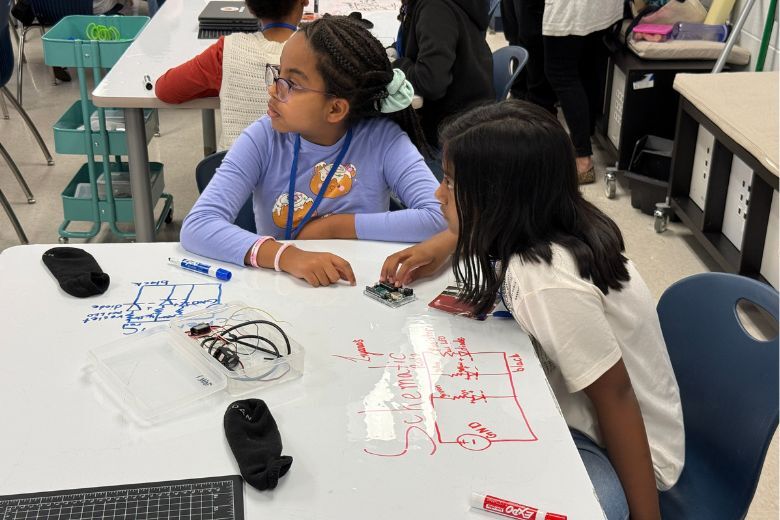Copyright WTOP

A new lab, which opened at Bucknell Elementary School in Alexandria, Virginia, is giving Fairfax County elementary school students a shot at engineering and computer programming. And the results are as imaginative as they are innovative. The Thinkabit Lab designs and builds prototypes for environmentally friendly inhalers, pet-washing machines, glasses with digital dashboards that monitor activity and soccer ball shooting robots. And the engineers behind this broad range of contraptions haven’t yet graduated the 5th grade. When students arrive at the Virginia Tech-partnered lab, they often show a mix of excitement and apprehension. But about an hour later, many of them will go from little to no programming experience to building a device of their own. “We do a lot of hands-on skills, where they’re actually building circuits that they design, and then they program them, and then we have them build automated devices,” Jim Egenrieder, director of Virginia Tech’s D.C.-area K-20 Technical Education and Workforce Development programs, told WTOP. By the end of the class, students build or improve robotic devices that perform a task of their choosing. What they choose to build, is up to them. Clemente Smothers, a student at Keene Mill Elementary School in West Springfield was visiting the lab on a recent day. Smothers told WTOP he decided to build a hybrid machine that could shoot a baseball or soccer ball, so players can learn to field the balls. Another student, Betty Abraham, said her idea came from a recent article she read that stated “inhalers cause pollution.” “We want to create an inhaler that doesn’t cause as much pollution,” Abraham told her teacher. Abraham then described her prototype, which she planned to build with cardboard, small electric motors and LEDs. “This is a micro dose of project-based learning where they get to decide what they want to create, and we facilitate it,” Egenrieder said. “We try to never say ‘no’ unless safety is involved, and that’s freedom that students don’t often have in their daily lives.” Students have about 35 minutes to complete their inventions. “If you are not done, and most of them see that as failure, I make sure that I tell them it’s part of the engineering and design process,” said teacher Jessica Ittayem, a STEM specialist at Bucknell Elementary. “If you didn’t have enough time communicate to us, what if you had three more days? How would this look? How would it function?” She said parents often report trips to Home Depot, so their children can finish their prototypes at home. Before diving into hands-on learning, students receive a brief lecture on programming and engineering basics and are asked to reflect on their values and interests. Their first task: program a miniature traffic light using green, yellow and red LEDs, a breadboard, resistors and a computer. Once they grasp the basics, they can control how quickly the lights change — sometimes so fast that all three appear lit to the human eye, though a phone camera reveals they’re blinking. “We had some problems at first,” said student Leanna Mollik. “It’s really fun, and it can determine your career in the future.” She told WTOP this is one of her favorite classes. After the stoplight, students learn to program a servo and motor before starting their own projects. “They leave saying, ‘That was more fun than I thought it would be. This is the best field trip we’ve ever had. I can see myself doing this,’” Egenrieder said. “And they hopefully go home and have dinner table conversations about these new ideas.” He said these children, who will likely be working into the 2080s, are “going to need skills that survive the integration of artificial intelligence. And the dispositions to adapt to the many, many changes that are happening more rapidly than any other technology integration we’ve seen.” All students at Bucknell Elementary go through the lab for an hour at least once a week, students visiting the lab from other schools get four hour windows on Tuesday and Thursday to visit the lab. All Bucknell Elementary students visit the lab for an hour, at least once a week. Students from other schools get 4-hour windows on Tuesdays and Thursdays. Bucknell Principal Rashida Green said the most important part of the experience is the spark students feel while working on their projects. “I think it’s when the light bulb goes off — ‘Oh my gosh, look what we were just able to code,’” she said. Green told WTOP her own college-aged daughters went through the program at a different school. “I just remember as a parent coming home and having conversations with them,” she said. “They were so excited about the experience. And so, you know, it definitely makes an impact on them.” Get breaking news and daily headlines delivered to your email inbox by signing up here. © 2025 WTOP. All Rights Reserved. This website is not intended for users located within the European Economic Area.



